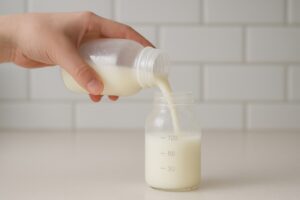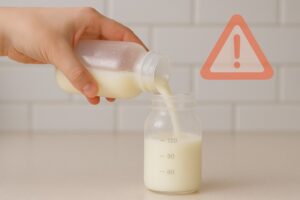Why Moms Often Ask This Question
If you’ve been pumping multiple times a day, you’ve probably wondered: “Can I just mix my freshly pumped milk with the one I stored in the fridge earlier?”
It’s a very common question for busy moms trying to save storage space and time. But when it comes to your baby’s safety, temperature balance and hygiene matter more than convenience.
👉 Before trying this method, check out our detailed post How to Know If Breast Milk Is Bad (Signs & Smell Guide) to learn how to identify spoiled milk before mixing.
Understanding the Temperature Rule
Yes, you can mix refrigerated breast milk with fresh milk — but only if both are at the same cool temperature.
Freshly expressed milk is warm, while stored milk from the fridge is cold (around 39°F or 4°C). If you pour warm milk into cold milk directly, the temperature rises and bacteria can grow more quickly.
The Safe Approach:
Cool the freshly expressed milk first by placing it in the fridge for about 30–60 minutes. Once it feels as cold as the stored milk, gently swirl (not shake) them together in a clean, sterilized container. Always label the new bottle or bag using the earliest pumping date, because that determines its safe storage time.
The CDC’s official breast milk handling guide strongly emphasizes this rule — keeping milk at the same temperature before combining ensures freshness and prevents bacterial growth.
Step-by-Step: How to Safely Combine Fresh and Stored Milk

- Cool the fresh milk first: Place it in the refrigerator for 30–60 minutes.
- Check both temperatures: Both batches should feel equally cool to the touch.
- Use a clean, sterilized container: Always mix milk in a sanitized bottle or storage bag.
- Label carefully: Write down the earliest date of expression.
- Store safely: Keep the mixed milk in the fridge for up to 4 days or freeze immediately if not using soon.
👉 For travel situations, see our practical guide How to Store Breast Milk on the Go (Portable Storage Safety Guide).
How Long Mixed Milk Lasts
Once you combine fresh and refrigerated milk, its storage time depends on the oldest batch in the mix:
- In the refrigerator: Up to 4 days (counting from the earliest milk date).
- In the freezer: Up to 6 months for best quality.
- At room temperature: Use within 2 hours once warmed.
Remember — once reheated, breast milk should never be refrozen or stored again.
Safe Mixing Guidelines (Explained Simply)
If you’re unsure when mixing is safe, here’s how to think about it:
If your milk is freshly expressed and about an hour old, and you have another batch that’s already 12 hours old in the fridge — you can mix them only after cooling the fresh one to the same cold temperature.
Never pour warm or body-temperature milk directly into cold or frozen milk. It changes the milk’s structure, affects nutrients, and increases the chance of spoilage.
If both milks are cold — for example, a 4-hour-old batch and a 2-day-old batch — you can mix them safely, but always use the earliest date when labeling.
However, if you’ve just pumped warm milk and your other milk is frozen, thaw the frozen one separately before cooling both to the same temperature. Only then can you safely combine them.
Common Mistakes Moms Make

- Pouring warm milk directly into cold milk.
- Forgetting to match temperatures before combining.
- Labeling with the wrong date.
- Shaking milk too hard instead of swirling gently.
- Keeping mixed milk for more than four days in the fridge.
Following these simple steps keeps your baby’s milk both nutrient-rich and bacteria-free.
For more verified information, visit Mayo Clinic’s Breast Milk Storage Guidelines.
The Science Behind Mixing: Why Temperature Matters
The biggest reason for cooling both batches first lies in the fat layer separation that happens naturally in breast milk. When warm milk touches cold milk, the fat and water layers blend unevenly, breaking down vital nutrients.
Cold milk protects immune compounds such as lactoferrin and immunoglobulins, which fight infection and support your baby’s growth. Mixing milk at equal temperatures helps preserve these nutrients and ensures every bottle gives the same rich nutrition.
FAQ: Common Questions About Mixing Milk
Q1: Can I mix milk pumped at different times of the day?
Yes — but always match temperatures first and label with the earliest pumping date.
Q2: Can I combine thawed milk with fresh milk?
Not directly. Let the frozen milk thaw completely and cool the fresh milk before combining.
Q3: What if I accidentally mixed warm milk into cold milk?
It’s best to use that milk immediately and not store it again.
Q4: Should I shake milk after mixing?
Avoid shaking — swirl gently to protect the fat molecules and nutrients.
Conclusion: Smart Mixing Keeps Milk Safe and Nutritious
You can safely mix refrigerated breast milk with fresh — but only after cooling the fresh batch.
This simple habit prevents bacterial growth, keeps nutrients stable, and ensures your baby gets milk that’s both safe and balanced.
Always remember: temperature consistency and proper labeling are the secrets to safe storage. Follow the CDC and Mayo Clinic recommendations to make milk management easier, safer, and stress-free for you and your little one.



